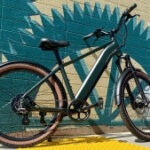When it comes to bike tires, you might find yourself wondering if tire sizes should always match. Sometimes, bikes come with mismatched tires, and while it could simply be due to availability or a previous owner’s choice, there are specific reasons why someone might opt for a larger front tire. Let’s delve into the advantages and disadvantages of having a Big Front Wheel Bike setup.
One key benefit of a wider front tire is enhanced grip. This is particularly noticeable in wet conditions or during hard braking. Pneumatic tires rely more on adhesion than friction, essentially conforming to the tiny imperfections of the road surface. A wider tire, especially when run at a lower PSI, increases the contact area with the pavement. This greater engagement with road irregularities translates to superior grip. Imagine trying to stop quickly on a wet road – that extra contact patch from a bigger front tire can make a significant difference in preventing skids and maintaining control.
Furthermore, a larger front tire influences your bike’s handling by increasing the trail. This results in a more stable steering feel. However, stability isn’t always desired by everyone; some riders might perceive this as slower or less responsive steering. Whether this is a pro or con largely depends on personal preference and riding style. Riders who prioritize stability and predictable handling, especially on varied terrain, might appreciate the effect of a larger front tire.
On the flip side, a wider front tire does come with aerodynamic drawbacks. It presents a larger frontal area to the wind, increasing aerodynamic drag compared to a narrower tire. Additionally, unless you have very modern rims specifically designed for wider tires, the aerodynamic profile of your wheel may not be optimized for a 28c tire or larger. This mismatch can amplify the aerodynamic penalty, as wheels are a significant factor in overall bike aerodynamics. For cyclists focused on speed and efficiency, especially in flat or rolling terrain, this aerodynamic impact is a considerable disadvantage.
While the focus is on the front, it’s worth briefly considering wider rear tires for context. A wider rear tire primarily enhances comfort. The increased air volume allows it to absorb bumps and road vibrations more effectively, even at the same tire pressure as a narrower tire. Moreover, you can further reduce tire pressure in a wider rear tire for even greater comfort. Many cyclists find that rear tire choice has a more pronounced impact on ride comfort than the front. Aerodynamically, the rear tire is somewhat shielded by the rider’s body, minimizing its aerodynamic penalty compared to the front. Finally, rear tires tend to wear out faster due to drive forces and weight distribution; a wider tire can offer increased longevity.
However, it’s technically true that a rear tire offers more cornering grip potential than the front. Despite this, most non-motorist cycling accidents are braking-related. Under braking, the front tire is always the limiting factor in grip, unless you have an exceptionally oversized front tire and an unrealistically rearward weight distribution – a scenario unlikely in typical cycling.
In conclusion, opting for a big front wheel bike, or more specifically, a bike with a wider front tire, presents a trade-off. You gain enhanced grip and potentially increased steering stability, which are beneficial for control and confidence, particularly in challenging conditions. However, you may sacrifice some aerodynamic efficiency. The best choice depends on your riding priorities, typical riding conditions, and personal preferences.

